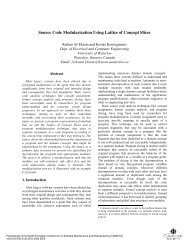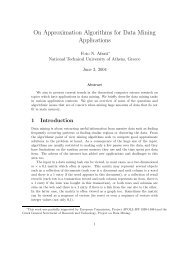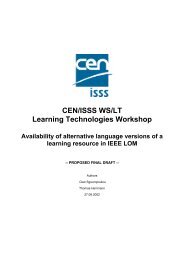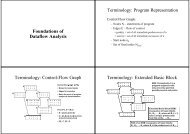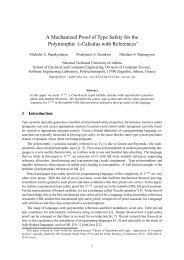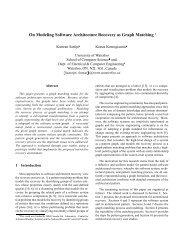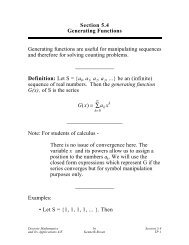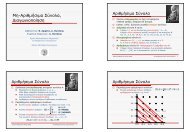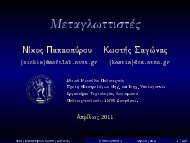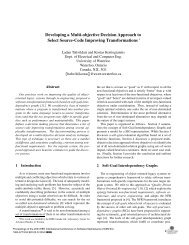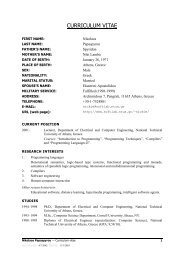Manual
Manual
Manual
You also want an ePaper? Increase the reach of your titles
YUMPU automatically turns print PDFs into web optimized ePapers that Google loves.
Chapter 3: Bison Grammar Files 49<br />
at the end): you have to count the actions along with the symbols when working out which<br />
number n to use in $n.<br />
The mid-rule action can also have a semantic value. The action can set its value with<br />
an assignment to $$, and actions later in the rule can refer to the value using $n. Since<br />
there is no symbol to name the action, there is no way to declare a data type for the value<br />
in advance, so you must use the ‘$n’ construct to specify a data type each time you<br />
refer to this value.<br />
There is no way to set the value of the entire rule with a mid-rule action, because<br />
assignments to $$ do not have that effect. The only way to set the value for the entire rule<br />
is with an ordinary action at the end of the rule.<br />
Here is an example from a hypothetical compiler, handling a let statement that looks like<br />
‘let (variable) statement’ and serves to create a variable named variable temporarily<br />
for the duration of statement. To parse this construct, we must put variable into the symbol<br />
table while statement is parsed, then remove it afterward. Here is how it is done:<br />
stmt: LET ’(’ var ’)’<br />
{ $$ = push_context ();<br />
declare_variable ($3); }<br />
stmt { $$ = $6;<br />
pop_context ($5); }<br />
As soon as ‘let (variable)’ has been recognized, the first action is run. It saves a copy<br />
of the current semantic context (the list of accessible variables) as its semantic value, using<br />
alternative context in the data-type union. Then it calls declare_variable to add the<br />
new variable to that list. Once the first action is finished, the embedded statement stmt<br />
can be parsed. Note that the mid-rule action is component number 5, so the ‘stmt’ is<br />
component number 6.<br />
After the embedded statement is parsed, its semantic value becomes the value of the<br />
entire let-statement. Then the semantic value from the earlier action is used to restore<br />
the prior list of variables. This removes the temporary let-variable from the list so that it<br />
won’t appear to exist while the rest of the program is parsed.<br />
In the above example, if the parser initiates error recovery (see Chapter 6 [Error Recovery],<br />
page 83) while parsing the tokens in the embedded statement stmt, it might discard<br />
the previous semantic context $5 without restoring it. Thus, $5 needs<br />
a destructor (see Section 3.7.7 [Freeing Discarded Symbols], page 57). However, Bison currently<br />
provides no means to declare a destructor for a mid-rule action’s semantic value.<br />
One solution is to bury the mid-rule action inside a nonterminal symbol and to declare<br />
a destructor for that symbol:



